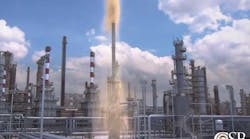Regulatory Update: New Safety Alert on Hazards of Emergency Discharges from Pressure Release Valves
On March 6, the U.S. Chemical Safety and Hazard Investigation Board (CSB) issued a new Safety Alert titled “Hazards Posed by Discharges from Emergency Pressure-Relief Systems.” The alert highlights hazards identified with emergency pressure-relief systems from four CSB investigations.
The alert advises facilities that while a discharge from emergency pressure-relief systems can help protect equipment from unexpected and undesired high-pressure events, it can also seriously harm or fatally injure workers and cause extensive damage to a facility if the discharge is not made to a safe location.
“All four of the incidents highlighted in the CSB’s safety alert underscore the importance of thoroughly evaluating emergency pressure-relief systems to ensure they discharge to a safe location where they will not harm people," said CSB Chairperson Steve Owens, in a statement
The four incidents highlighted in the CSB’s safety alert resulted in 19 deaths and 207 injuries. They include:
- On May 19, 2018, an ethylene release ignited, injuring 23 workers at the Kuraray America, Inc. ethylene and vinyl alcohol copolymer plant in Pasadena, Texas. The CSB’s animation of this event shows how this incident occurred during the startup of a chemical reactor system following a turnaround. High-pressure conditions developed inside the reactor and activated the reactor’s emergency pressure relief system, discharging flammable ethylene vapor horizontally into the ambient air in an area where a number of contractors were working.
- On November 15, 2014, approximately 24,000 pounds of highly toxic methyl mercaptan were released from an insecticide production unit at the E.I. du Pont de Nemours and Company (DuPont) chemical manufacturing facility in La Porte, Texas. The release fatally injured three operators and a shift supervisor inside a manufacturing building. During the early phases of the investigation, CSB investigators identified a number of worker safety issues—separate from the release scenario— including that several emergency pressure-relief systems at the facility were designed to discharge hazardous materials in a way that posed a risk to workers and the public.
- On May 4, 2009, highly flammable vapor released from a waste recycling process, ignited, and violently exploded at Veolia ES Technical Solutions, LLC, in West Carrollton, Ohio. The incident injured four employees, two seriously. Following the initial explosion, multiple other explosions occurred that t significantly damaged every structure on the site. Residences and businesses in the surrounding community also sustained considerable damage. The CSB concluded that uncontrolled venting from emergency pressure-relief valves to the atmosphere allowed tetrahydrofuran (THF) vapors to accumulate to explosive concentrations outside process equipment, and the vapors subsequently found an ignition source.
- On March 23, 2005, during the startup of an isomerization unit following a maintenance turnaround, a series of explosions occurred at the BP refinery in Texas City, Texas. The incident fatally injured 15 workers and injured an additional 180 workers. During the startup, a distillation tower flooded with flammable hydrocarbons and was over-pressurized. This activated the tower’s emergency pressure-relief system, which created a geyser-like release from the vent stack and formed a flammable vapor cloud that soon ignited and exploded.
“OSHA requires employers to provide a safe workplace. Effective and safe pressure relief systems help ensure safe operations of plants across the country,” said CSB Board Member Catherine Sandoval, in a statement. Using findings from these four incidents the CSB’s safety alert issues three key lessons for facilities.
1. Follow existing good practice guidance.
2. Evaluate whether the atmosphere is the appropriate discharge location or if there are safer alternatives.
3. Ensure hazardous chemicals vented into the atmosphere discharge to a safe location.
The alert also calls on companies to evaluate and, when appropriate, update their emergency pressure relief systems to prevent future incidents and protect workers and surrounding communities from harm.
“Our safety alert calls on companies to evaluate and, when appropriate, update their emergency pressure relief systems to prevent future incidents and protect workers and surrounding communities from harm,” said Board Member Sylvia Johnson, in a statement.
The CSB’s core mission activities include conducting incident investigations; formulating preventive or mitigative recommendations based on investigation findings and advocating for their implementation; issuing reports containing the findings, conclusions, and recommendations arising from incident investigations; and conducting studies on chemical hazards. The agency's board members are appointed by the president and subject to Senate confirmation. The Board does not issue citations or fines but makes safety recommendations to companies, industry organizations, labor groups, and regulatory agencies such as OSHA and EPA.
